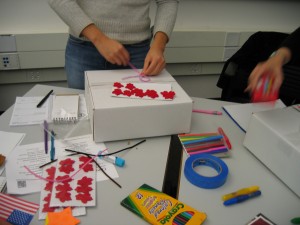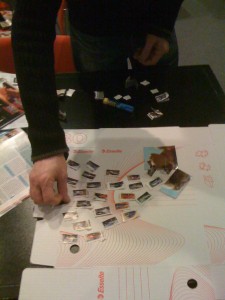“Bob’s House” marked a milestone for PepsiCo, for sign language and Deaf folks, and for the SuperBowl. This commercial aired as part of the pre-game activities in 2008. If you haven’t seen it, check it out by clicking on the image above.
Summary of the key points of the narrative
Two men are driving through a residential neighborhood at night, blaming one another for not knowing which house is Bob’s. The driver leans on the car’s horn, arousing the occupants of the darkened houses who turn on the interior lights, peek outside and even step onto a now lighted porch. The one house that remains dark must be the one belonging to their deaf friend. They park, ring the doorbell, and enter as their host Bob signs and mouths “sorry” to his neighbors. The passenger’s “We’ll miss the kick-off” cues the viewer that it’s Superbowl time; the driver drinking from a Pepsi bottle suffices to identify the sponsor.
Deaf culture
This commercial captures a traditional bit of Deaf folklore, in which creating noise annoys hearing people and simultaneously allows identification of the Deaf target of interest. Deaf (written with a capital D) carries the implication of cultural identification with the community that shares values, behaviors, and sign language. The usage follows the civil rights movement’s embrace of term “Black” from an ethnic slur to an identity of pride. (Little “d” deaf refers to the audiological condition of hearing impairment, where a deaf person cannot perceive the unaided auditory signal to understand speech. The term “hard of hearing” may refer to a person whose hearing impairment is less severe, as measured by a hearing test, but also has a sociological meaning, referring to the person with an audiological impairment who functions within a speech environment more easily, through hearing aids and speechreading.)
Beyond the narrative structure of the commercial, which reproduces a familiar sign language joke in a film treatment, there are additional messages in the commercial that indicate its genuine portrayal of Deaf culture.
- Deaf (and deaf) people can drive
The National Fraternal Society of the Deaf (founded 1901, closed in 2004) provided life insurance to deaf people who couldn’t qualify with other companies. The Frat functioned as a social service and advocacy group as well. Â It meets for the last time in early March 2010 to close the books. As with many charitable institutions which hope their mission will be accomplished, the Frat is closing in part because deaf people no longer suffer discrimination in insurance coverage, but also because there are other mechanisms and organizations which handle the advocacy portions of its mission. - Turning on the dome light helps visual communication in the dark
The driver turns on the light in the car to have the argument with the passenger about who was supposed to bring the street address. - Doorbells become flashing lights
Perhaps you caught the fact that the guests’ doorbell press triggered flashing lights inside Bob’s house, a visual signal of a typically auditory message. Harris Communications is one of several companies that supplies specialty products, including vibrating alarm clocks and flashing lights hooked to audio signals, for the specialized audience, “Deaf and Hard of Hearing people, people interested in sign language, Deaf Culture, hearing loss and more.” Hmmm, sounds like everyone, doesn’t it?
The companion video presents the employees who perform in the commercial, capturing their genuine surprise and delight about sharing the Deaf world with the Superbowl audience.
Congratulations to PepsiCo for responding to a Deaf employee’s suggestion, and for involving the National Association of the Deaf in turning the suggestion into reality. The performers in this video are not necessarily trained as actors, but the authenticity of their signing is obvious to Deaf and signing audiences.
Here’s the big question: Â What products shall we make so that we don’t have to retrofit the environment?
Additional resources:
Carol Padden & Tom Humphries, “Deaf in America: Voices from a culture” explicates of the foundations of Deaf culture through stories, jokes, poetry and the perspective of a Deaf-centered world.




